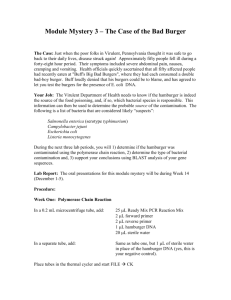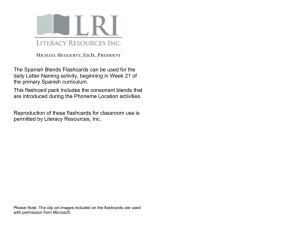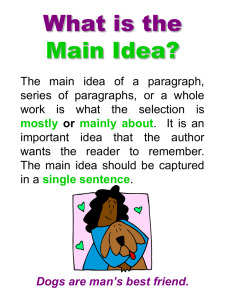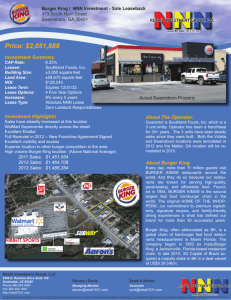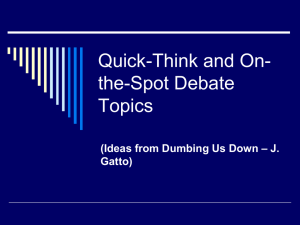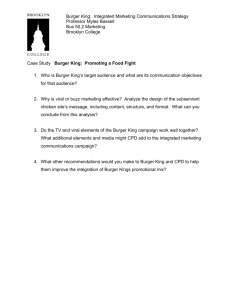Why is there no ham in a hamburger
advertisement
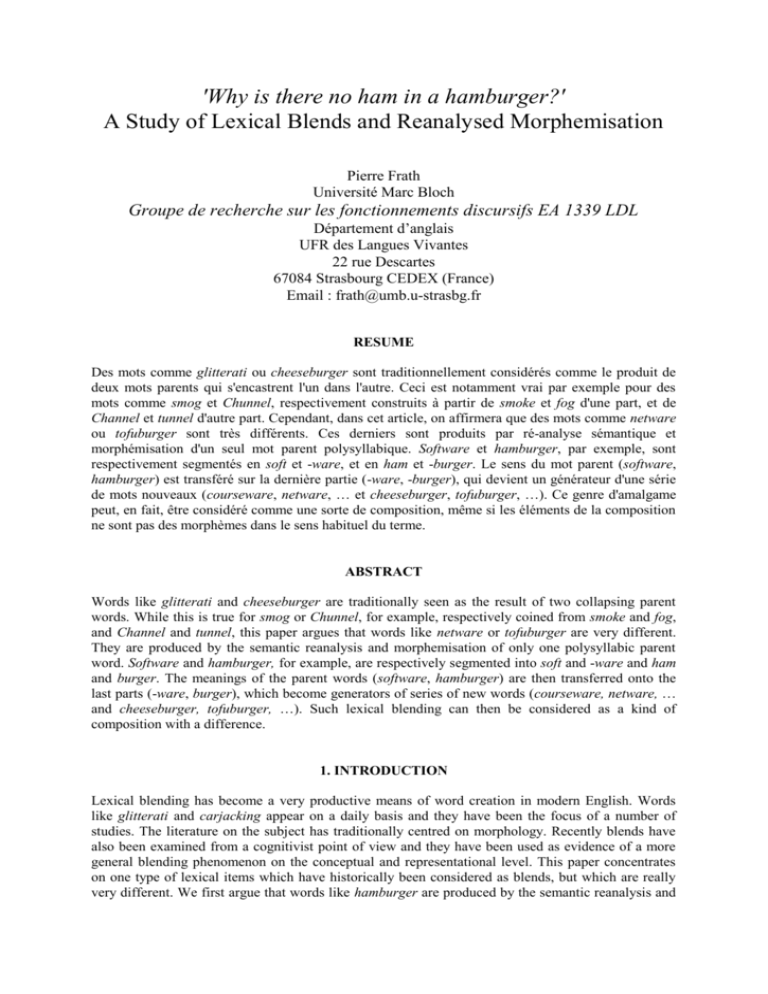
'Why is there no ham in a hamburger?' A Study of Lexical Blends and Reanalysed Morphemisation Pierre Frath Université Marc Bloch Groupe de recherche sur les fonctionnements discursifs EA 1339 LDL Département d’anglais UFR des Langues Vivantes 22 rue Descartes 67084 Strasbourg CEDEX (France) Email : frath@umb.u-strasbg.fr RESUME Des mots comme glitterati ou cheeseburger sont traditionnellement considérés comme le produit de deux mots parents qui s'encastrent l'un dans l'autre. Ceci est notamment vrai par exemple pour des mots comme smog et Chunnel, respectivement construits à partir de smoke et fog d'une part, et de Channel et tunnel d'autre part. Cependant, dans cet article, on affirmera que des mots comme netware ou tofuburger sont très différents. Ces derniers sont produits par ré-analyse sémantique et morphémisation d'un seul mot parent polysyllabique. Software et hamburger, par exemple, sont respectivement segmentés en soft et -ware, et en ham et -burger. Le sens du mot parent (software, hamburger) est transféré sur la dernière partie (-ware, -burger), qui devient un générateur d'une série de mots nouveaux (courseware, netware, … et cheeseburger, tofuburger, …). Ce genre d'amalgame peut, en fait, être considéré comme une sorte de composition, même si les éléments de la composition ne sont pas des morphèmes dans le sens habituel du terme. ABSTRACT Words like glitterati and cheeseburger are traditionally seen as the result of two collapsing parent words. While this is true for smog or Chunnel, for example, respectively coined from smoke and fog, and Channel and tunnel, this paper argues that words like netware or tofuburger are very different. They are produced by the semantic reanalysis and morphemisation of only one polysyllabic parent word. Software and hamburger, for example, are respectively segmented into soft and -ware and ham and burger. The meanings of the parent words (software, hamburger) are then transferred onto the last parts (-ware, burger), which become generators of series of new words (courseware, netware, … and cheeseburger, tofuburger, …). Such lexical blending can then be considered as a kind of composition with a difference. 1. INTRODUCTION Lexical blending has become a very productive means of word creation in modern English. Words like glitterati and carjacking appear on a daily basis and they have been the focus of a number of studies. The literature on the subject has traditionally centred on morphology. Recently blends have also been examined from a cognitivist point of view and they have been used as evidence of a more general blending phenomenon on the conceptual and representational level. This paper concentrates on one type of lexical items which have historically been considered as blends, but which are really very different. We first argue that words like hamburger are produced by the semantic reanalysis and 2 morphemisation of polysyllabic words; we then generalise the observations made for hamburger for other series of words. The problem is also considered from a historical and constrastive point of view in the final section. 2. MORPHOLOGICAL DESCRIPTIONS Archetypal blends are of the sort Lewis Carroll called portmanteau words in Through the Looking Glass. Examples are chortle and slithy, respectively coined from chuckle and snort, slimy and lithe. This is Humpty-Dumpty's oft-quoted original definition of portmanteau words. `Well, "SLITHY" means "lithe and slimy." "Lithe" is the same as "active". You see it's like a portmanteau -- there are two meanings packed up into one word.' Other examples include smog (smoke and fog), motel (motor and hotel), Chunnel (Channel and tunnel), Medicare (medical and care), brunch (breakfast and lunch), Oxbridge (Oxford and Cambridge), camcorder (camera and recorder), telethon (telephone and marathon), breathalyser (breath and analyser), docusoap (documentary and soap opera), sexcapade (sex and escapade), warnography (war and pornography), dictocrat (dictator and democrat), palimony (pal and alimony), etc.1 Blending seems to be a rather productive process of lexical creation in modern English. Blends have been studied extensively in the literature and a number of classifications have been proposed. Kemmer (2000) has subdivided her selection of blends into three main categories. There are overlap blends (glitterati, MacIntrash, …); there are substitution blends, divided up into lexeme substitutions (carjacking, earwitness, …), morpheme substitutions (andropause, interquel,…), syllable substitutions (ginormous, digerati, …), and segment string substitutions (smog); there are also rare blends, divided up into 3-source blends (turducken), intercalative blends (chortle, slithy), and spelling blends (pharming). Yet there are problems with Kemmer's typology. For example, why should digerati and glitterati, or earwitness and andropause, be in two different categories? Kemmer's aim is probably not to establish a definite typology. She looks at the morphology of blends from a semantic and phonological point of view and she draws general conclusions such as “phonological strings can trigger meaning” and “blends show the primacy of words over the bound morpheme”. For Kemmer, “linguistic units are processing units and are blended online in language use”. Blending is seen as “a general process”. Adams (1966), quoted in Tournier (1985, pp. 130-138) organises blends into five categories: i) 'expandables', for example Chunnel, which can be expanded into Channel tunnel, ii) 'conjunctives', for example smog, which is built on smoke and fog, iii) 'non-expandables' such as anecdotage, which cannot be expanded into anecdote and dotage (which is meaningless), iv) 'neo-Latin' such as aquacade (aqua + cavalcade), where one of the parts is a Latin or Greek morpheme and v) 'derivational': one of the parts is an affix, such as -nik in sputnik, which gave beatnik. Tournier remarks that the conjunctive category should actually be considered as a part of the expandable category. He also says that beatnik is not a blend at all because it is constructed by suffixation. Tournier does not elaborate on the matter, which is central to this paper, and we shall go back to it in the following sections. Adams’s categories cover the ground quite exhaustively but except for the expandable / non-expandable categories, the classification criteria seem somewhat disparate, which may be an indication that blends are in fact a mixed bag of phenomena. Such a multi-criteria classification cannot make sure that one item does not belong to two categories at the same time or prevent that related words are put in different categories. For example, aquacade is in the neo-Latin group because it contains a Latin morpheme. But then the obviously related motorcade cannot be put in the same category. This may be the reason why Adams drops structured classification altogether in her recently published book (Adams 2001, pp. 138-141). She describes a variety of blends, with remarks on their unintentional or deliberate character, on their syntactic nature, on their motivation, on constraints, on 1 Many examples in this paper are taken from Kemmer (2000) and Paillard (2000); others have been collected by the author, mostly from Time Magazine, streets and shops in the UK, or supplied by the author's native Englishspeaking informants. 3 spelling, etc. She defines blends as 'made up of two contributory words' and we shall come back to this definition in section 4. Algeo (1977) offers a coherent 'structural' classification which centres on morphology. There are 'blends with overlapping' (slang + language = slanguage), 'blends with clippings (fan + (maga)zine = fanzine), 'clippings at morpheme boundaries' (para(chute) + troops = paratroops), 'blends with clippings and overlappings' (mot(or) + (h)hotel) = motel), 'blends with imperfect overlapping', etc. Most authors note that there are various constraints on blending. The parent words must somehow fit into each other on both the phonological and the semantic levels. If the phonemes of the blended words do not match, extra phonemes may be inserted. For example, Tournier notes that contrivance and conception have not produced contrption: an a was inserted to facilitate pronunciation (contraption). As for meaning, he remarks without elaborating that the semantic contents of the parent words are both present in the blend. Such a very general statement may be an indication that the semantic constraints on blending are not too harsh and that practically anything goes on the semantic level. Word order on the other hand appears to be a more powerful constraint. Portmanteau blends result from two collapsing parent words. When the parent words are specifier/noun-type phrases (such as Channel tunnel), the original word order is kept in the blend (Chunnel). When the two parent words are on equal footing (as in breakfast and lunch, Oxford and Cambridge), the blended parts' order is determined by fortuitous accident (it would be difficult to blend lunch and breakfast in that order), or by usage. Cambridge and Oxford could have been blended into Camford, but were not because of usage conventions. A query in the British National Corpus Sampler CD-ROM, a corpus of about 2 million words, lists the following Oxford and Cambridge collocations: advocated a new relief university for Oxford and Cambridge at Stamford become a rival establishment to both Oxford and Cambridge confined printers to London, York, and Oxford and Cambridge universities third medieval academy alongside Oxford and Cambridge and threatened secession of Cambridge and Oxford students in 1264 is mentioned only two hundred Cambridge and Oxford students, converted to Pelagianism Oxford always precedes Cambridge when the universities are referred to; Cambridge may come first when some other referent (in this case students) is concerned. Blending is generally considered as a kind of composition with a difference, generated by a taste for playful linguistic creations and for abbreviations. English speakers have a long tradition of puns, plays-on-word, spoonerisms and portmanteau words, to which Lewis Carroll gave a literary legitimacy. Also, there is probably a general dislike in most languages, and certainly in English, for long denominations. A denomination is a linguistic form endowed with fixed meaning, as opposed to discursive meaning. For example a green belt is a fixed form designating a peripheral zone outside an urban area with forests and fields (a denomination); a blue belt is a belt that happens to be blue (an open phrase with discursive meaning). Denominations tend to be shortened when they are too long, probably because they only need to be recognised, and short ones are more easily recognised than longer ones. A compact disk is a CD, genetically modified food is GM-food, the Central Intelligence Agency is shortened into CIA, and hardly anyone knows what MI5 stands for. To recapitulate something is to recap it, a brassiere is a bra, not to mention pram (perambulator), moped (motorcycle with pedals), TV, telly (television), etc. The various descriptions of portmanteau blends can be summarised as follows. They are the oneoff product of two2 parent words which seem to be merged into one another. There can be total interpenetration, morphology permitting, as in Chunnel, chortle, smog, etc., where both parent words contribute equally to the blend. There can also be concatenation with various degrees of interpenetration, as in brunch, Oxbridge, camcorder, docusoap, (no interpenetration), or Medicare, palimony, warnography, sexcapade (some concatenation, some interpenetration). Portmanteau word formation is subjected to various constraints and is caused by a general tendency to abbreviate denominations and also, probably, by a playful linguistic tradition. 2 Kemmer (2000) mentions two 3-source blends: turducken (turkey + duck + chicken) and motormobilia (motor + automobile + memorabilia), but they seem somewhat artificial and rather opaque. Maybe we find it difficult to blend more than two words. 4 3. COGNITIVIST ACCOUNTS Blends have recently been the focus of a number of linguistic studies in cognitive linguistics. Their main attraction is that they seem to be in harmony with some cognitivist assumptions on language and the mind. This section will be devoted to Turner and Fauconnier's view on the matter. Turner and Fauconnier's theory rests on the notion of mental space originally put forward by Fauconnier in his seminal book Espaces mentaux (1984). "Mental spaces are small conceptual packets constructed as we think and talk, for purposes of local understanding and action. They are interconnected, and can be modified as thought and discourse unfold. Fauconnier and Turner have recently proposed the existence of a general cognitive process - conceptual blending - that operates over mental spaces as inputs. In blending, structure from two input spaces is projected to a separate space, the 'blend'. The blend inherits partial structure from the input spaces, and has emergent structure of its own (Fauconnier and Turner 1996, p. 1). Each of these small conceptual packets is somehow linked to words. On hearing for example 'my hike along the Appalachian trail in Carlisle, Pennsylvania 1990' (Turner and Fauconnier 1995, p.2), I am prompted to build a mental space from parts of the conceptual domain of journey, hike, hiker, Carlisle, etc. Chunnel is explained as 'a conceptual construction that integrates structure from both the generic frame of a tunnel and the knowledge frame of a body of water between England and France. This integrated unit can serve as the site for integrating a great range of knowledge, from the relevant geology to problems of engineering ...' (Turner and Fauconnier 1995, p. 10). Blending is considered as 'a central process of grammar' (title of the 1996 paper), operating at the morphological, lexical (dolphin-safe, fool-proof) and sentential levels (he sneezed the napkin off the table). Blends such as Chunnel differ from normal compounds by way of some 'fortuitous accident' (Turner and Fauconnier 1995, p. 10): a phrase (the tunnel under the Channel, or Channel tunnel) integrates the conceptual domains of Channel and tunnel; it is then further integrated into Chunnel, 'given the phonemes of Channel and tunnel' (Turner and Fauconnier 1995, p. 10). The whole point of the theory is to defend the notion that 'expression is not compositional encoding that mirrors a compositional conceptual construction'...' (Turner and Fauconnier 1995, p. 6). In other words, the meaning of a complex linguistic structure does not proceed from the meaning of its parts 'in the usual way', i.e. simple concatenation of lower-level semantic units, which, the authors argue, could not account for the different meanings of safe in dolphin-safe, shark-safe and child-safe. According to them, safe is linked to a mental space, of which a different part is selected by, respectively, dolphin (meaning safe for dolphins), shark (meaning area without sharks and safe for bathers) and child (meaning children cannot tamper with the object and hurt themselves). The selected parts are then integrated with the conceptual domains of dolphin, shark and child respectively and produce new blended mental spaces. Also, if complex meaning was nothing but concatenation of lower-level semantic units, how is it, the authors argue, that a blend such as McJobs conjures up much more meaning than the sum of its constituents, i.e. more than just the content inherited from the fastfood and job mental spaces? The McJobs mental space creates content of its own; it is able to attract bits and pieces from other domains such as the plight of unemployment, etc. For Turner and Fauconnier (and also for Kemmer), blends are evidence of a more general blending phenomenon which takes places at the conceptual level and which produces lexical and sentential blends. The authors use blends as a way to bypass the compositionalist problem and to account for the link between language and mental representations. Yet the very notion of representation is considered dubious by many authors. A whole section of modern philosophy, largely based on what is known as Wittgenstein's second philosophy, specifically rejects the notion of representation in the mind. Many authors, John Searle among them (Searle 1999), have extensively criticised cognitivist assumptions, and even Francisco Varela, a stalwart of cognitivism, offers an alternative to representation (his 'enaction' theory) in chapter 5 of his 1988 book. Instead of using blends as evidence of some (hypothetical)3 phenomenon, this paper will focus on a 3 There are alternatives to cognitivist theories. For some studies based on usage, see for example (Frath 2001a, 2001b, 2001c, 2002, 2003). 5 detailed morphological description of one particular type of word formation usually considered as a blend, namely hamburger-type words. 4. HAMBURGER: STUDY OF A PROTOTYPE Kemmer mentions that some blends are the locus of new morpheme emergence. As examples she lists the hamburger series (cheeseburger, baconburger, veggieburger...), the hardware series (software, wetware, freeware, shareware, fatware, vaporware, etc.), the alcoholic series (workaholic, chocaholic, coffeeholic, cocaholic, sexaholic, computerholic, etc.), the sequel series (prequel, interquel), etc. (Kemmer 2000). These series will be extensively studied in section 5 and it will become apparent, we hope, that they are constructed on a very specific pattern, which is not recognised in Kemmer's paper. Elsewhere, Kemmer puts interquel and sexaholic under the same general heading as portmanteaus such as smog and edutainment, which is evidence that the hamburger, hardware, alcoholic and sequel series are considered as blends with a difference. Adams uses the 'derivational' feature of the -nik series as one of five criteria to classify blends, which is another indication that hamburger type words are recognised as different but they are nevertheless thought of as blends, albeit in a subclass of their own. In (Adams 2001) she defines blends as 'made up of two contributory words' (cf. section 2), but then mentions series such as resistor, transistor, neuristor and hotel, boatel, motel, lorrytel. Yet, is neuristor a blend of neuron and resistor, or is it directly constructed on the suffix -istor, abstracted from transistor? Adams' section on blends is part of a more general chapter on Reanalysis, and indeed reanalysis is at work in such series. We shall argue that words like boatel and neuristor are not produced by two contributory words. Tournier’s passing remark that beatnik is not a blend (see section 2) will be developed and it will be shown that portmanteaus and hamburger-type words, or H-types, are very different. Portmanteau blends are one-off words produced by two collapsing parent words (smoke + fog = smog), whereas H-types are produced by the semantic reanalysis and morphemisation of one polysyllabic parent word which becomes a generator of a whole new series of words. This means that H-type word formation is very close to ordinary compounding and affixation and that H-types are not blends at all. This section is devoted to an extensive study of hamburger; the following will offer a generalisation of the process of H-type word creation. According to the Chambers Dictionary of Etymology4, hamburger is first mentioned in 1908, 'from earlier (1889 American English) Hamburger steak, borrowed from German Hamburger, of or from the city of Hamburg; perhaps so called because this type of steak may have originated in Germany and was associated with the city and port of Hamburg, from which many immigrants came to the US'. Indeed, according to some German informants, there is a local speciality in the North of Germany which consists of a meatball in a roll called Frikadellen Brötchen. So we may safely hypothesise that German immigrants, probably from Hamburg, introduced the Frikadellen Brötchen into the US, which the Americans then quite logically named Hamburger steak: the sort of steak eaten by people from Hamburg. Hamburger steak then became hamburger tout court. The same sort of mechanism is at work for example in Frankfurter (sausage), French fries (French fried potatoes), National Geographic (Society), etc., so this is nothing out of the ordinary. It seems that the noun can be dropped in some noun phrases, probably because it is unnecessary for comprehension. On ordering a Frankfurter, uttering sausage after Frankfurter will not give more information about what I want. In a French café, un crème stands for un café-crème, for the same reason. As a result, the specifying adjectives become nouns (as in Frankfurter), and the secondary specifying nouns become the main nouns (as in un crème). What is more extraordinary is the shortening of hamburger into burger, first recorded in 1939 according to the Chambers Dictionary of Etymology. Cheeseburger was first recorded in 1938 and beefburger in 1940. Dating first occurrences is probably not an exact science, so we may hypothesise that hamburger somehow generated beefburger and cheeseburger towards the end of the 30's and that this process coincided with the semantic reanalysis of hamburger which produced the 4 1988 edition 6 morphemisation of burger. According to the Chambers Dictionary of Etymology, burger was 'recognised as a distinct word element or combining form in 1941'. Was the morphemisation of burger cause or consequence of the generation of cheeseburger and hamburger? This point will be discussed in section 6. Burger has since been used with all sorts of specifiers: baconburger, eggburger, porkburger, chickenburger, vegi burger (or veggie, or vege, or veg), fishburger, tofu burger. Burger is also used in phrases such as 1/4lb burger, 1/2lb burger, veg&rice burger, veg&cheese burger5 etc. Burger is clearly a word in its own right which can be used in compounds or open phrases, just like any 'normal' word like pie (apple pie, pork pie, steak and kidney pie) or belt (corn belt, sun belt, green belt, muessli belt). The difference is that burger is not a morpheme in the usual sense: the only 'legal' morphemes of hamburger are hamburg- and -er, and maybe at a secondary level, ham- (probably the same origin as home, or German heim, or French hameau) and -burg (city, fort, castle). Normal composition should produce cheese-hamburger to name a hamburger with cheese, baconhamburger a hamburger with bacon, etc. But this is not what happened. There is surely a 'fortuitous accident' at work here, as Turner and Fauconnier say. Those who used X-burger for the first time (with X standing for any specifier) probably did so in a playful way. The ham syllable maybe prompted them to change the content of the roll and specify the new burger with the word denoting the new content: pork, cheese, beef. Frankfurter was not shortened into furter probably because frank does not mean anything in connection with food. Cheeseburger has the same meaning as cheesehamburger, and it is easier and faster to pronounce. Why does the literature lump H-types with portmanteaus? Probably because it could be argued that cheeseburger is a portmanteau blend of cheese and hamburger. This argument could hold for the initial creation of the first -burger word (cheeseburger in 1938), but not for subsequent blends. Tofuburger is clearly constructed on burger alone: it does not result from the shortening of tofuhamburger. Also, this theory cannot explain why burger has become a word in its own right. Yet some portmanteau words are potential H-types, for example sexcapade (drugscapade and boozecapade are conceivable). In that case, the -capade morphemes would be endowed with some semantic autonomy. Another example is software, which is certainly not a portmanteau of soft and hardware. But we shall return to this in the following section. To sum up this section, the hamburger series functions in exactly the same way as normal compounds (such as apple pie or green belt). The only difference is the morphemisation of burger, which is the result a playful linguistic use, maybe triggered by the resemblance of the ham-syllable with a word of the domain, and a widespread tendency to shorten denominations, also at work in other types of abbreviations. Can these observations be generalised? 5. OTHER H-TYPE WORDS: TOWARDS A GENERALISATION Other H-type words include the software series (courseware, netware, vapourware, freeware, shareware, emailware, etc.), the Watergate series (Irangate, Contragate, Monicagate, Whitewatergate, Camillagate, travelgate), the sequel series (interquel, prequel), the alcoholism series (workaholism, sexaholism), the literati series (glitterati, digerati, soccerati, britpoperati, etc.), and many more, but these will be enough for our purpose. A common pattern is discernible here. These series all have a polysyllabic parent word which is subjected to reanalysis, segmentation and morphemisation and the meaning of which is transferred on the last syllable(s). For example the meaning of the parent word software (an immaterial set of instructions which runs on a computer) is transferred on -ware, which frees a slot for a specifier: courseware is educational software, vapourware is non-existent software, etc. Watergate has come to symbolise a scandal involving the political establishment. Transferring this meaning to -gate allows the formation of an open-ended series of words denoting political scandals (Irangate, Monicagate, etc.). A prequel is a sequel whose story takes place before another one. For example Star Wars IV is a prequel, because although it was made after the three others, it features a story which took place 5 Some of these compounds are written in either one or two words, with or without hyphens. We use the transcription which seems more common. 7 before the first episode. An interquel is a sequel whose story takes place in between two previous episodes. The notion of sequel is clearly transferred onto the last syllable, -quel, which becomes a morpheme thanks to the paradigmatic variation of the first syllable. The same process is at work in alcoholism (work-, sex-), and in the literati series where the meaning of literati (the knowledgeable) is transferred on the -rati syllable. Thus britpoperati are people who know everything about British pop, soccerati are soccer experts, etc. This pattern of transferring the whole meaning of a parent word to its last syllable is very productive in modern English. Nanobots are nano-robots, probably the first of a long series of -bots6. A femcho is a female macho, where -cho has come to mean something like 'too assertive'. Thus a macho is a male -cho (with a folk hamburger-type morphemisation), and a femcho is a female-cho. Can kidchos (overly assertive children ), teenchos (overly assertive teenagers) and greychos (overly assertive OAPs) be very far away? See also the history / herstory series, whose count stops at two for want of suitable possessive determiners (itstory? ourstory? mystory? etc.) The reanalysed -quel, -aholism and -rati morphemes do not exist in unbound form: there is no such thing as a rati or a quel. This is also the case with more 'normal' words like the dinosaur series (dinosaur, stegosaur, tyrannosaur, brontosaur, brachiosaur, dryosaur, megalosaur, titanosaurs (large dinos), carnosaurs (carnivorous dinos), etc.). Although the -saur morpheme is 'legal' (dinosaur was coined from existing Greek words meaning terrible and lizard), there is no such thing as a saur. So, once the reanalysed morphemisation of the -quel, etc. type is accepted, the -quel series functions on the same pattern as dinosaur or the -raptor series (oviraptor, velociraptor, etc.). The -ware and -gate morphemes, on the other hand, are words in their own right and do possess an independent composition capacity. For example, software (1960) was patterned on hardware, in much the same way as cheeseburger was patterned on hamburger. The computer machinery was quite naturally called hardware by the first computer scientists, a standard word denoting tools, equipment, machinery, which in turn begged the formation of software for the immaterial part of the system. The hardware/software couple was later complemented by wetware, a word denoting the brain as opposed to the computer. Also, the original meaning of -ware (material objects) is still in use to create new words such as Agaware (the paraphernalia sold with Aga stoves) or canalware (canal-related tourist junk for sale near canals). Burger has achieved the full status of an independent word of the ware and gate sort. If it were not for the puzzling existence of hamburger with its weird first syllable, burger would be the only standard denomination. Yet it seems that burger is the only reanalysed morpheme to have achieved full lexical autonomy. Maybe it is because of length of use. Maybe some day a rati will be an expert, a quel a sequel, a holic an addict, etc. To sum up this section, H-types are constructed on a polysyllabic parent word by semantic reanalysis, segmentation and morphemisation, and transfer of meaning to the last part and paradigmatic permutation of the first part. In some cases the last part is an existing noun, such as in software or Watergate. In other cases, a folk morphemisation takes place, as in sequel, hamburger or literati. In both cases the last part of the parent word carries the meaning of the whole and serves as a basis for the new series. 6. A HISTORICAL AND CONTRASTIVE VIEW OF H-TYPES One puzzling feature of H-types is that they seem to be a rather modern feature of language. Adams mentions a few blends from earlier centuries such as foolosophy (OED1592) and knavigations (OED 1590). "Only in modern times have [blends] been recorded in appreciable numbers" (Adams 2001, p.141). Even so, none of Adams' examples are H-types. The oldest occurrence in English seems to be the hamburger series and burger seems to be the only case of unbound reanalysed morpheme, with the exception maybe of bot, but it would have to be confirmed by further usage. Even more puzzling is that most H-types have actually been coined very recently and that the pace of creation seems to be 6 This sentence was first written August 2000. The May 14, 2001 issue of Time Magazine features the word 'bot in the title of a paper ("With a Little Help from my 'Bot") about a brand of mobile service robots, Care-O-Bots. The apostrophe may signal that the journalist does not consider the unbound existence of the word as assured. Also, players of some internet games (such as Quake) use the word bot to refer to robots. 8 accelerating. Apparently some mechanism has been set loose and has become a major means of word creation. This section looks into the matter from a historical and contrastive point of view. H-types probably piggy-back on existing reanalysis and affixation processes. Reanalysis seems to be a very common feature of language. Adams (2001) mentions many examples. 'Some suffixes, like dom,-hood and -less, were once also words, cf. Old English on drybtlicestum dome, 'in most noble state', papan had, 'papal dignity', firena leas 'free from crimes'' (p. 131). There is an element of reanalysis in a number of linguistic phenomena: affixation (deface and deprive, for example, generate the affix -de, which is then used in words like debowel and deforest); backformation (for example sipid is abstracted from insipid, to laze from lazy), shortening (where shortened version of words acquire autonomy, such as cello, copter, prefab, etc.), and of course, blends. Such a creative morpho-semantic re-use of words and morphemes seems indeed very common. In French, new words are often constructed by suffixation. For example chaiserie, a new word referring to a shop selling chairs, is patterned on crèmerie, boulangerie, pâtisserie, etc. English also makes use of this possibility, for example teledildonics (sex through the Internet). The tele- and (n)ics are standard affixes, and so is the French -(e)rie suffix. New suffixes have been created recently in French in much the same way as the -rati, -gate and -holic morphemes. For example -ciel is a reanalysed morpheme segmented from logiciel, a word meaning software which was constructed on logique (logics). The -s phoneme of logi/S/iel comes from existing derived words such as logicien (logician) and logicisme (logicism). Therefore a 'normal' morphemic segmentation should be logic-iel. Yet logiciel generated a -ciel series: graticiel (freeware), didacticiel (courseware), progiciel (professional software), etc. The same happened with informatique (informatics), which was originally constructed from information and électronique. A 'normal' segmentation should be informat-ique, but a -tique morpheme appeared instead which generated robotique, bureautique, télématique, domotique, etc. There is a difference between the French -tique and -ciel morphemes and the English -burger and rati : they are clearly considered as suffixes with a weak meaning, with no potential for autonomy at all. What they have in common is a total disregard for existing 'legal' segmentations. There may be cultural reasons at work here. In the past, most English-speaking scientists and journalists, arguably the two largest groups of word creators, also had a literary background which included grammar and at least a smattering of Latin, Greek and French. This may explain why many neologisms were created from these languages and followed morphological 'rules'. Nowadays there are more people without this background engaged in word creation. Most of the computer lexicon was created by young Americans with no literary background at all. Another reason may be an expanding taste for linguistic games which is also noticeable in pop culture, journalese, advertising, etc. Maybe this playful use of language unhampered by scholarly knowledge allows speakers to segment words more freely. Why are there so few unbound burger type words? A comparison with what is happening in French might be enlightening. The oldest burger type word we discovered for this research is the French word bus. The first Parisian public transport company was created in 1828. It consisted of a fleet of large horse-drawn coaches which were meant to be a means of transport for everyone, and not just for the rich. In those days, many people knew that one of the meanings of the Latin word omnibus was for everyone. The coaches were subsequently named omnibus, which was quickly shortened into bus7. Bus later generated autobus, abribus, Airbus, etc. Omnibus entered the English language in 1832 and bus in 1838. Omnibus is seldom used except in a phrase designating the average person, as in the man on the Clapham omnibus. Other examples include the vélo, auto and moto series. Vélocipède was shortened into vélo with the same meaning (bicycle), which generated vélocross, vélo tout terrain, vélodrome, vélomoteur, véloski, etc. Also motocyclette, which gave moto, motocross, moto-école, motoneige, motoski, etc., and automobile, which gave auto, auto-école, autobus, autochenille, autocouchette, autodrome, autoradio, auto-stop, etc. The difference with hamburger is that the parent words (omnibus, vélocipède, motocyclette and automobile) are hardly used: the shortened versions have replaced the longer words. 7 Information found in Le Monde, 11-12 mars 2001, p. 16, in a Letter to the Editor by a reader, Gabriel Périn. 9 This may be a clue as to why there are so few unbound reanalysed morphemes. Bus, vélo, moto, auto were first abbreviations of rather long and learned words artificially coined from Greek and Latin morphemes. They were used in compounds only when the abbreviations had gained full word status. Watergate and alcoholic on the other hand were not first abbreviated into gate and holic (with gate meaning political scandal) and then used in compounds. The -gate and -holic morphemes were abstracted at the very moment the first H-type of the series was produced (probably Irangate and workaholic). They never had an independent existence. If this is true, French H-types should also fail to produce unbound reanalysed morphemes. There are not very many H-types in French. We could only find two, the bikini / monokini series, and the container series. The bikini two-piece bathing suit produced monokini in the 60's when women started to wear topless bathing suits. The garment was originally named by French designer Louis Réard after the atoll in the Marshall Islands where the US carried out several atomic bomb tests, presumably because of its 'explosive' effects on men (Chambers Dictionary of Etymology). Reanalysed morphemisation separated bi- from -kini, which became the sole carrier of the bathing suit meaning. The bi- slot could then be occupied by mono-, and monokini meant a one-piece topless bathing suit. Yet the kini morpheme never enjoyed an independent existence. Monokini went out of use when topless bathing became very common. A more recent example is the cubitainer / vinotainer series built on container. Cubitainers and vinotainers are small wine containers, 'happy boxes' in English supermarket parlance. The -tainer morpheme does not exist in unbound form. It was suggested in section 5 that burger is the only unbound reanalysed morpheme because it is also the most ancient. Another explanation could be that hamburger was first shortened into burger on the bus pattern and that cheeseburger and beefburger are nothing but ordinary compounds. More probably, as is suggested by the dates given by the Chambers Dictionary of Etymology, the two processes (abbreviation and morphemisation) coincided. Cheeseburger was created in 1938 and beefburger in 1940. Meanwhile, burger first appeared in 1939 and was recognised as a word in 1941. So maybe hamburger is really not so prototypical at all. We shall know which explanation is correct in a few decades when, or if, other bound morphemes become words in their own right. To sum up this section, H-type word creation resembles ordinary suffixation. The difference lies in the unconventional emergence of a morpheme which is abstracted from the first H-type of the series. It is a case of reanalysis, also at work in other linguistic phenomena. It remains to be seen if H-types are capable of producing unbound morphemes on the burger pattern. 7. CONCLUSION Blends have traditionally been described in terms of morphology. We noted that the descriptions which take the portmanteau word as the archetypal blend do notice the specificity of hamburger-type words but use the difference only as a discriminating factor to classify blends. We analysed H-types as series of words which originate in the reanalysed morphemisation of one single polysyllabic parent word, the transfer of the meaning of the whole to the last part of the word, and the paradigmatic permutation of the first part. Portmanteau blends on the other hand are one-off words produced by two collapsing parent words. Cognitivists have used blends as evidence of a more general blending phenomenon which is supposed to take places at the conceptual level and which may produce lexical blends, morphology permitting. This paper has offered a morphological description of H-types, which function as compounds with a difference: H-type suffixes are the result of semantic reanalysis and segmentation of polysyllabic words. H-type word creation and blending may be linked to the emergence of new cultural attitudes towards language. REFERENCES ADAMS Valérie (1966): A Study of the Process of Word-blending and an Examination of the Types found in present-day written English. University College, London (unpublished Master's dissertation). ADAMS Valerie (2001): Complex Words in English. Pearson, 2001. 10 ALGEO John (1977): 'Blends, a Structural and Systemic View'. American Speech, 52/1-2, pp. 47-64. FAUCONNIER Gilles (1984): Espaces mentaux, Les éditions de Minuit, Paris. FAUCONNIER Gilles and TURNER Mark (1996): 'Blending as a Central Process of Grammar', expanded web version of 'Blending as a Central Process of Grammar' in Conceptual Structure, Discourse and Language, edited by Adele Goldberg, Stanford, Center for the Study of Language and Information (CSLI), Cambridge University Press, pp. 113-129. FRATH Pierre (2001a): 'Polysemy, Homonymy and Reference', Proceedings of the JASGIL Seminar, Strasbourg 5-6 May 2000, Albert Hamm ed., in RANAM (Recherches Anglaises et NordAméricaines), n° 34, 2001, Strasbourg. FRATH Pierre (2001b): ' Lexical Meaning, Reference and Usage', in Proceedings of the First International Workshop on Generative Approaches to the Lexicon, Pierrette Bouillon and Kyoko Kanzaki, eds., University of Geneva, April 26-28, 2001. FRATH Pierre (2001c): “Sens lexical et usage”, in Des théories aux problématiques. Actes de SEMIO 2001, Université de Limoges, 4-8 avril 2001. FRATH Pierre (2002): 'Etude du verbe commencer en contexte', Journal of French Language Studies 12.2 (2002), pp 169-180, Cambridge University Press FRATH Pierre (2003): 'Metaphor, Polysemy and Usage', in Phraseological Units: Basic Concepts and their Application. David Allerton, Nadja Nesselhauf, Paul Skandera, eds., Basel, Schwabe. KEMMER Suzanne (2000): 'Lexical Blending: An integrated View, with Implications for Morphology', presented at First Landau International Symposium, Germany, March 2000. PAILLARD Michel (2000): Lexicologie contrastive anglais-français, Ophrys, Paris. TOURNIER Jean (1985): Introduction descriptive à la lexicogénétique de l'anglais contemporain. Champion-Slatkine, Paris, Genève. TURNER Mark and FAUCONNIER Gilles (1995): 'Conceptual Integration and Formal Expression' in Journal of Metaphor and Symbolic Activity, Mark Johnson, ed., volume 10, number 3. SEARLE John (1999): Mind, Language and Society. Weidenfeld & Nicolson, London. VARELA Francisco (1988, 1996): Invitation aux Sciences Cognitives. Le Seuil, Paris. WITTGENSTEIN Ludwig (1963): Philosophical Investigations. Blackwell, Oxford.
